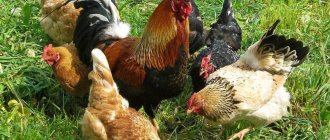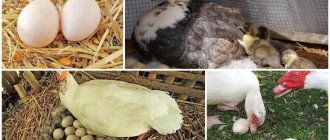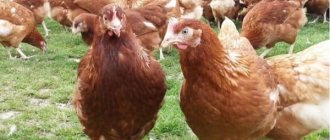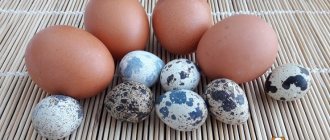2 328
no comments yet
3
Author:
Rasskazov Pavel.
Reading time: 3 minutes
Surprisingly, the best hens are considered to be outbred laying hens, as well as chickens of meat and meat-egg breeds. Such birds, as a rule, have a well-developed brooding instinct. To hatch chickens, birds aged 2 to 4 years are used. Hens who have already done such work before show their maternal qualities best.
Recommendations for poultry farmers
Raising chicks by a hen is an invaluable aid for the poultry farmer.
The hen allows you to save time, labor and effort of the owner. But the process requires control, a competent approach and knowledge of the nuances. Breeding nuances:
If there are several hens in the house, and the owner places them on eggs, then the nests should be located at a distance of 1 m. When the first chickens hatch, they should be taken carefully, replacing them with dummies. If the hen notices the substitution, she will get up from the nest and will not sit in it again.
Professional breeders do not recommend sending eggs to hens in batches to hatch more chicks. This technique can destroy the hen’s desire to care for her offspring. If the hen gets scared and runs away from the nest, she needs to be returned and covered with a basket for several days. For hens, it is better to take individuals of the Cochin, Kuchin Jubilee, Brahma or Welsumer breeds. They are caring mothers and take excellent care of their offspring. Using traditional methods of planting, they do not need to be planted on eggs. They perform all duties independently.
Using brood hens to hatch chicks is a convenient and easy way to produce offspring. She will independently regulate the temperature, moisture and turn the eggs.
Proper care of the hen during the brooding period contributes to the successful hatching of chicks
Choosing eggs to hatch
Eggs are selected based on appearance. They must have a pear-shaped or oval shape, be without shell defects, various growths and thickenings.
Be sure to read:
How to properly trim the wings of chickens and roosters and other poultry?
You can select them using a special device - an ovoscope. It illuminates the air chamber and determines the position of the yolk. A healthy egg has an offset air chamber and a centrally located yolk.
How to arrange and where to place a nest for a hen
The nest is isolated from birds on an earthen area in a dim corner of the room. The poultry house must have a comfortable temperature (about +20 degrees), dryness and good ventilation.
Holes in the ground with crumpled straw or hay are suitable for placing nests. Wooden boxes with soil and straw will do.
How and how many eggs to place under a hen
You can put 14 eggs under 1 hen. In addition to chicken eggs, it is allowed to add up to 6-8 eggs from ducks, geese or turkeys. Eggs should be laid at night or in the dark evening.
The nest where the hen will hatch her eggs should be quite comfortable
To prevent the chicken from getting up, you need to cover it with a basket for a couple of days. During this time, the chicken must be released to eat and drink.
When you need human help: how to put a chicken on eggs
Even if a hen has an innate maternal instinct and has proven herself to be a good hen, the bird may, for some reason, refuse to sit in the nest, abandoning the chicks.
At this moment, the chicks need human help. The chicken needs to be given vitamins and minerals, and then forcibly placed under the eggs, covered with a basket for a couple of days. In this case, all factors that serve as a nervous irritant for the hen are excluded - other pets, predators, unexpected guests, etc.
Hatching of young animals. Caring for a hen with chicks
Hatched chick
When the first chick hatches, you will hear it squeak. After some time, when it dries, take out the newborn and place it in a cardboard box or basket, cover it with a light cloth (preferably gauze) and place it in a warm place where the temperature is between 26-28 degrees.
Next, the chicks will begin to hatch one after another. Some of them can be helped to emerge by carefully breaking the shell. By the way, it is advisable to immediately remove all egg shells from under the hen.
After hatching is completed, when all the chicks have hatched, dried out and turned into cheerful yellow lumps, you can begin to let them go under the hen. The chicken will provide them with optimal care and better care. It is advisable to place chickens in the evening. The optimal number is 20-25 chicks. It is better to keep the brood hen and brood separately from other birds.
Read about how to properly care for chickens and feed them in the first days of life:
Selection and preparation of a hen
It is not difficult to identify a good hen in a herd - the maternal instinct is manifested by frequent and restless clucking, egg laying decreases, and the hen periodically moves into the nest.
If you notice these signs, remove the chicken and examine it for disease.
The mucous membrane should have a healthy color, and there should be no parasites in the feather. If necessary, carry out curative or preventive treatment against insects.
It also happens that none of the chickens in the population shows any inclination to hatch eggs. Poultry farmers have learned to stimulate the instinct of motherhood and call this the forced method. For this purpose, an individual with hatching experience is selected. Old hens that hardly lay eggs anymore are suitable; they often become good hens.
The bird is placed in a nest, dummies of eggs are placed, and the chicken itself is covered with a basket. Within a few days, the hen gets used to the role of mother, after which the dummies are replaced with hatching eggs. Before planting in the nest and during the brooding period, the hen needs special housing conditions and a balanced diet.
What to do with the brood immediately after hatching
It is necessary to prepare a warm box, into which the born chicks are immediately removed, and they wait until the rest hatch. Chicks should not be in a draft, so the box needs to be covered, a heating pad placed down, and a blanket placed on top. A small hole is left for ventilation, and the temperature is maintained at +30 °C. The dried chicks are returned to the hen. For the first food you need millet, boiled chopped yolk and fresh water.
Did you know? Chickens can hatch not only their own eggs, but also other birds (ducks, geese, swans).
Hatching eggs by a hen is suitable for personal farming. For industrial needs, an incubator is better suited.
The process of hatching eggs
Before we talk about the process itself, it should be noted that a good brood is not only the merit of the chicken, but also the efforts of the person himself. After all, a large part of success depends on the quality of the eggs. This includes the health of the rooster, the living conditions of the birds, proper feeding, and normal fertilization of eggs. We remember that chickens lay eggs without a rooster, but their fruits are no longer suitable for hatching offspring.
The normal ratio of rooster to hen numbers is on average one male per 10-12 females. However, in heavy breed groups this figure drops to one rooster per 6-10 hens.
To obtain offspring, you should take only fresh, clean eggs without visible defects and of the correct shape. It is better if these are products for a period of 5-8 days; more than 10 is already too much, since the viability of the embryo decreases. Often such eggs can be “defective”
If you store them for about a week in order to accumulate the required amount, then it is important to turn them every day in different directions. Store this product at a temperature of 10-15 degrees
Some nuances
So, if you recently got chickens and want to try to get offspring for the first time, you should know some nuances. Firstly, this is the hen herself.
Mother hen - as practice shows, the “maternal” instinct is best developed in heavy breeds. They are less active and are able to sit in one place for a long time
It is important for every owner to choose the right hen for his brood. Such a chicken must be in a special natural state of “motherhood”. Firstly, its body temperature rises, its comb becomes a little duller than usual, the bird clucks and shows nervousness.
The nest is a separate room from the rest of the chickens, a warm and cozy place, paved in a convenient way so that the eggs do not roll out. The nest is most often made of straw. Hatching process - before you put a hen on eggs, you must be sure that she can fulfill the role of a hen and mother. For this, it is not enough just the fact that the bird clucks
It is important to check her desire in practice. To do this, take porcelain eggs and place them in the chicken’s nest.
If it sits well and calmly for a couple of days, then you can already add real “live” food.
How a chicken hatches eggs
What does it mean for a chicken to hatch eggs? This means that the hen constantly sits on them and warms them with her warmth. At the same time, she maintains a constant temperature of about 37.8 ° C, and from time to time she turns her paws so that the embryos warm up evenly on all sides.
Of course, the bird gets up from the nest every day to eat, drink water, relieve itself and walk around a bit. While sitting, nothing should distract or irritate the chicken. Her cage should be in a calm, secluded and dark place.
How many days does a chicken sit on eggs?
The entire incubation process lasts 21 days. During this time, the embryos in the eggs have time to fully form, and the chickens hatch. True, it sometimes happens that in the process of warming up, the hen deliberately throws one or two eggs to the side. They need to be removed as they are a “defective” product. In such cases, the fetus either freezes or is completely absent.
How to stop a chicken from hatching eggs
Chickens have their own natural schedule, and this schedule often does not coincide with our needs. This also applies to the process of hatching eggs. It would seem that summer has passed, autumn has come, and several laying hens are croaking. Can this be stopped and weaned off? Yes, there are several simple secrets on how to wean a bird from incubation for a short period. At least until spring, since then her “maternal” instinct will still be useful to us.
The oldest folk method is to “bathe” a laying hen in cool water. You can dip it into a small barrel, but not with your head naturally. Why does this work? There are several versions: the first is that the chicken is stressed, the second is that it is hypothermic and its body temperature decreases.
For some individuals, staying several days in an empty cardboard nest without bedding or eggs helps. Others stop clucking after living for several days in a lonely enclosure. The owner himself must decide which method to choose, since birds are different and everyone has this instinct differently developed.
What to do if after 21 days the chicks have not appeared
When answering the question of how many days a chicken hatches eggs, they usually indicate a maximum period of 23 days, but in practice, owners try to ensure that the chickens hatch at the same time. Strong chicks hatch first, weak ones may linger. If 23 days have not passed, they do not require human help, otherwise, when kept at home, pecking is stimulated.
To help the chick be born, you need to gently press the shell in the area of the chick's head so that it cracks. Then parts of the shell are removed and the head and neck of the chick are freed, and then the whole body.
Chicks cannot be taken from the nest immediately; they must dry out and come to their senses.
The chicks hatch one by one. As they appear, the shells are removed from the nest
It happens that the chick is never born. There are several reasons:
- hypothermia or overheating of the egg;
- non-compliance with humidity conditions;
- genetic defects of the embryo.
Sometimes the hen herself accidentally deforms or crushes the eggs.
What to do after a chicken lays on the clutch
To get healthy chicks that, with proper care, will turn into beautiful chickens, there are many things to consider.
First of all, it is important to remember that the best time for planting is spring, since the young brood will have enough warm time to grow and get stronger for the winter. Summer and autumn are not the best period for hatching chickens; it is recommended to artificially cool the hens’ desire to hatch
Not every individual is able to sit for the entire period
Therefore, it is also equally important to choose a suitable hen so that she can fully cope with her task. This is easy to do at home
Chicken hatches eggs
Important! First of all, her specific behavior will indicate her readiness: she constantly clucks, lingers for a long time in the nest with laid eggs, the hen begins to pluck fluff and feathers to decorate the nest, stops laying eggs and avoids the rooster. https://www.youtube.com/watch?v=-kcpgfckjeo
https://www.youtube.com/watch?v=-kcpgfckjeo
You can also recognize a hen by external changes. Loss of appetite and weight can be taken as a sign of readiness. Also, the hens' combs begin to decrease in size and become lighter in color.
Nest with decoy eggs
To get a good brood of healthy chickens, planting a chicken is not the only task
It is important to provide proper care. When a chicken sits on eggs, every owner should know what to do next.
True, care procedures should begin a few days after planting. During this time, you should not disturb the bird so as not to scare it away.
When a chicken sits on eggs, don't disturb it.
Now it’s worth considering the main recommendations.
General terms
In the room where the nest with the bird will be located, there should be silence, at least relative. For successful hatching, it is necessary to ensure constant twilight, calm and silence.
Temperature
Optimal temperature conditions are also the key to a successful result. If possible, the temperature should be 10-15 degrees with an air humidity of 75%. If you cannot create such conditions, then you should try to get closer to them.
Walks
Chickens definitely need walks.
To keep the eggs in the nest warm, they are covered with a cloth. The bird should walk in the fresh air for about 15-20 minutes. If the hen does not go to the nest on her own, then she should be forced back.
While the bird is doing its business, for example, eating or walking, you should help it put things in order. There is no need to change anything radically, just remove the dirt and waste products of the hen.
Important! You should also inspect the masonry. If there are broken or crushed eggs, they are simply removed
Nutrition
Throughout the entire brooding period, adequate nutrition should be provided. It is best that the food is not placed too far from the nest. In this case, the hen will not worry about her clutch.
Chickens need proper nutrition
Birds, like humans, love hygiene
Therefore, it is important to provide all conditions for such procedures. It is best to place a box of ash near the nest.
The bird simply loves to bathe in ash. In this way, she cleans her feathers of dirt and parasites. The bird should undergo similar procedures twice a week.
General recommendations
Chicks should hatch in 21 days. It is very good if there is an ovoscope that will help monitor the condition of the embryos. In the process, you can see pathologies and simply remove defective ones from the masonry. If a chicken sits on eggs, what to do next is clear. This will help create a comfortable environment for the chicken.
Chicks should hatch in 21 days
Newbie mistakes in poultry farming
Beginners often make a common mistake: they gradually introduce eggs under the hen and get chickens of different ages to hatch. As a result of negligence, hatching deadlines are violated and many chickens have to be left to “ripen” in an incubator or under another bird if there are any that are sitting. If you want to breed healthy livestock, then make sure that the quota settles on all specimens at the same time.
What to do if you can’t get the chicks to peck at the same time? Experienced farmers plant young animals in a separate box or basket. The “nursery” maintains a constant temperature of 26 to 28°C. After the process is completed, the chicks are given to their mother.
After the first clutch, the corydalis is able to hatch another or more. But you shouldn't experiment. The procedure is very exhausting for the chicken’s body and it takes some time to recover. If you need a continuous hatching process, then it is better to purchase an artificial incubator.
How to plant a chicken at home
To plant a bird at home, certain points should be taken into account.
It is important to choose the right individual for the role of a hen. You also need to know how to place a chicken on eggs correctly. There are several easy ways to get a chicken to sit on eggs, but first they need to organize the conditions for this
There are several easy ways to get a chicken to sit on eggs, but first you need to organize the conditions for this.
Preparing the site
First of all, they are engaged in creating a nest. It should be placed in a quiet, calm place so that no one disturbs or frightens the expectant mother.
However, the nest should not be too large. The best dimensions are considered to be 55x35 cm. If there is a lot of free space, part of the masonry may roll out.
DIY nest
Sometimes ordinary cardboard boxes or wooden boxes filled with straw are used. In the future, the hen herself will do everything for her comfort; for this she uses her own feathers and down.
Important! In order for chickens to lay eggs at the same time, sufficient space should be provided between the nests, as conflicts may arise between them. Hens can get their clutches mixed up or even start fighting with each other. Naturally, this will not do any good
Naturally, this will not be beneficial.
How to forcefully imprison a bird
Sometimes you can resort to artificially selecting a hen and forcefully placing her on the eggs.
There are two most common ways to get a chicken to sit on eggs at home:
- You can try to speed up the development of the chicken's natural desire. To do this, place dummies of eggs in a prepared nest and observe how the chicken behaves. Gradually she will begin to go to the nest more and more often. After some time, when she begins to spend almost all her time on the clutch, you can remove the dummies and lay real eggs.
- You can also choose your own bird to play the role of hen. The decoys are placed in the nest, which is located in a remote, quiet place. The selected chicken is placed on them and the room is closed so that it cannot leave. This will help unleash the maternal instinct. As practice shows, after 1-3 days she begins to cluck and will no longer want to leave the nest. If this does not happen, the bird is replaced.
Now it’s clear how to force a chicken to lay eggs at home. This will help control the chick hatching process.
Laying eggs
To get the right number of chickens, it is important to lay the eggs correctly, and even more so to select them. For incubation, use exclusively fresh eggs that were laid no earlier than 5 days before laying. Their shell should be clean, thick and without cracks
Their shell should be clean, thick and without cracks.
Laying eggs under a chicken
Important! It is best to use medium-sized eggs, since small ones most often have an incomplete embryo, and large ones may have two. How many eggs to choose for planting a chicken is determined by the dimensions of the hen itself. They should lie in one layer in the nest, and the hen’s body should completely cover them.
If the chicken is relatively large, then you can put about 13-15 pieces
They should lie in one layer in the nest, and the hen’s body should completely cover them. If the chicken is relatively large, then you can put about 13-15 pieces
How many eggs to choose for planting a chicken is determined by the dimensions of the hen itself. They should lie in one layer in the nest, and the hen’s body should completely cover them. If the chicken is relatively large, then you can put about 13-15 pieces.
It is allowed to lay eggs in two ways. You can suddenly lift the chicken and place the required number of eggs in the nest instead of decoys. Her reaction will tell about a good hen - she will instantly begin to push the eggs under herself with her beak.
You can place the eggs behind so that the bird does not understand and refuse to hatch. It is rarely possible to transplant from nest to nest; it is better not to risk it and just lay the eggs.
All eggs should be laid at once. It is not allowed to bring them some time after the others have been placed. After the first chicks appear, the hen will leave her nest, and the rest simply will not have time to hatch.
On a note. As practice shows, chickens can be successfully used to hatch chicks not only of their own, but also of other breeds and other species of birds.
What to feed the hen?
Chickens spend a lot of energy to heat their eggs. They need a lot of nutritious food. The diet will differ from the typical feeding table of egg or meat chickens. The diet is close to feeding roosters or broiler chickens:
| № | Helpful information |
| 1 | hen grains receive 50 g per day |
| 2 | While walking, chickens peck grass and look for insects and earthworms. The amount of green food is at least 60 g. Instead of green food, individuals can receive vegetables and root vegetables. Boiled potatoes, carrots, beets, pumpkin are good for them |
| 3 | the hen needs to be given protein supplements, cake, yeast - 8 g |
| 4 | fish or bone meal – 6 g |
| 5 | mineral supplements 8 g. As supplements, chickens receive shell rock, chalk, crushed egg shells, crushed shells |
| 6 | The hen drinks water to her heart's content. This is especially true if combined food is used for feeding. |
View this post on Instagram
Posted by Anna (@annabronnikova_) Aug 17, 2022 at 2:43 PDT
It is recommended to make mash for chickens at home. In addition to vegetables, grains, protein fillers, gravel is added to them. Stones improve digestion. For adult birds, choose medium-fraction gravel with a diameter of no more than 3 mm. Chickens should consume up to 2 grams of stones daily.
Which chickens are still better?
Many poultry farmers, after much testing and variation, have come to the conclusion that the best hens are outbred chickens. Their brooding instinct is very well developed.
At the same time, the body weight is normal, so there is no need to worry that the chicken will crush the eggs during hatching. Such a hen will be very attentive to her nest, take care of the “future generation” and will honestly “work out” the entire hatching period.
Chickens of meat-egg breeds will also be excellent hens. Provided they are of average weight. Hens with a large weight are not allowed to hatch, as the likelihood of producing offspring will be very low. The chicken will unconsciously crush the eggs with its weight. So this issue needs to be monitored very carefully.
Completely different eggs are placed under the hen. This is how purebred chickens and laying hens are often bred, in which the brooding instinct is very poorly developed. There are many cases in poultry farming when chicken eggs are placed under turkeys. This is practiced on large farms if not a single hen is going to lay eggs, but offspring are needed.
No matter how good the hen is, she needs to be provided with certain conditions in order to breed. It is advisable to select a separate nest, carefully ensure that other chickens do not lay eggs in the nest, maintain an optimal temperature and keep the flooring clean and dry. All these rules will allow you to achieve excellent offspring.
Typically, pure egg breeds of chickens are in demand at large poultry farms, where eggs are the main source of profit for the enterprise. But often in smaller farms they prefer to breed universal breeds or crosses, which are not only distinguished by the high productivity of laying hens, but also by the rapid weight gain of the young.
The main features of laying hens, comparison of egg production of different breeds, as well as the most productive varieties of chickens are the main topics of this article.
Optimal quantity
When the chicken, which has a brooding instinct, has passed the test, material tested by an ovoscope is placed under it. How many eggs can be placed under a hen depends on the breed (size) - standard numbers are 12-15 pieces. Miniature chickens can place 10-12 pieces under them, large ones - 15-17 pieces. Chickens can also hatch eggs:
- turkeys – 7-11 pcs.;
- ducks – 7-11 pcs.;
- geese – 5-7 pcs.
It is better to put an even number - it is believed that in this case the hatching of young animals will be better. The hen is placed on the clutch in the evening - this reduces stress levels and allows the bird to get used to it faster.
3 days before this, the chicken is examined for the presence of parasites, and if necessary, treatment is carried out. She is also provided with balanced food.
You cannot add new specimens during the incubation process - after the chicks from the main batch appear, the hen will leave the nest.
First stage: how to place a hen on eggs
Arranging a home for a hen
To hatch the future chicken generation, you need a very good mother hen, which is worth its weight in gold for any farmer, since not every hen is able to take on the responsibility of hatching and raising small chickens. Not all chickens inherit this natural quality, although in some cases this maternal instinct can be awakened by artificial means, which can be quite effective. As a result, even a “frigid” hen can become a good hen.
If a hen shows a desire to sit on the clutch and begins to cluck, it is necessary to provide her with a comfortable place to hatch her eggs. To do this, you need to make a separate nest in a darkened area of the chicken coop. First of all, you need to knock down a box of the appropriate size. A cozy chicken house 70 by 70 cm is quite suitable, which should be placed away from perches and feeders.
If you have several hens at once, then it is advisable to create a separate space for them from the rest of the chicken population, using various wooden partitions or chain-link mesh. Feeding hens and other procedures must also be carried out in isolation from the rest of the chicken family.
Laying eggs under the hen
First of all, you need to prepare fresh eggs. For one hen, 12 eggs are enough, although it is advisable to place this number only under a large individual. Broiler chickens are not intended by nature to incubate future offspring; this breed of chicken was created for other purposes, so it is very problematic to make laying hens out of them. Only purebred egg-laying breeds are suitable for breeding, although meat chickens can also be made into laying hens.
Before placing eggs under a laying hen, you need to make sure that they are fertilized. To do this, you can check them with an ovoscope or simply take clean and recently laid ones without various physical abnormalities. The main thing is not only to choose high-quality eggs, but also to properly stimulate the laying hen so that she sits on them. Whether the poultry will hatch its offspring or not, it all depends on your skills and abilities, which you must use in order to make a good hen out of a simple chicken.
The optimal period for starting incubation is usually considered to be the evening. Therefore, you need to place the hen in a pre-prepared nest after evening feeding, while covering the nest with a wicker basket.
Once a day it is necessary to release the hen for feeding. During the early stages of incubating eggs, the chicken should be fed only whole grains and given clean water to drink.
After four days, the basket can be removed, since the chicken is unlikely to get up from the eggs. During the incubation period, the hen tries to feed and drink very quickly, and then immediately hurries to the clutch.
Accidentally crushed eggs need to be promptly replaced, but such manipulations should only be done in the first few days.
After a week, the eggs can be checked using an ovoscope, but this must be done in the absence of the hen. Eggs that lack an embryo are immediately removed from the total mass.
On the twenty-first day from the moment they begin hatching, the chickens will begin to ask to come out and peck at the shell. But the hen is convenient because this process will take place under her strict control, unlike an incubator, where the poultry farmer himself must monitor and control the process of hatching and the birth of newborn chicks, observing the required temperature conditions.
How to control embryo development
Before the chicks hatch, the eggs are checked 3 times, exposed to light or with an ovoscope. This is not necessary to do more often, so as not to disturb the hen and not interfere with the development of the embryos. Check schedule:
- 1st time – every 7 days;
- 2nd time – in 11 days;
- 3rd time - in 18 days.
First inspection
The embryo is not yet visible, but the vessels feeding it should be well developed. If the chick has died or is not growing properly, they will be very dark or abnormally shaped. It happens that by mistake an unfertilized egg is placed on a chicken; upon examination, no changes are noticeable in it. Defective eggs must be removed from the nest, leaving only healthy ones.
Properly developing egg
Second follow-up inspection
At 11-12 days, the embryo and the vessels coming from it are already visible, which weave around the light space near the air cushion. If the vessels are not visible, then the egg can be thrown away.
Third follow-up examination
The embryo occupies almost the entire space and is visible as a large darkening. You can examine the neck and head of the future chicken, and sometimes notice its movements.
Note! Sometimes the hen herself rolls the egg out of the nest and leaves it lying on the floor. There is no need to put it back - it means it died, or the chick is not developing properly, and the bird, following instinct, gets rid of it.
Tips for choosing a hen
In order for a hen to hatch chicks, you need to choose a hen, since not every bird is ready to hatch eggs. Today, due to the fact that chickens are predominantly raised in incubators, the natural instinct to incubate eggs has been lost in most of them.
In some cases, it is possible to awaken the chicken's instinct to incubate, but this is not often possible.
A good hen (hen), which is instinctively ready to incubate and strives to sit on the eggs, begins to cluck, pulls out feathers and lines the bottom of the nest with them. She is also very reluctant to leave the nest.
If you try to forcibly drive her away, the chicken begins to fluff up her feathers, spread her wings, make a threatening cackle and try to peck. In order to finally confirm the seriousness of the bird’s intentions, dummies of eggs are placed under it. If she does not leave the nest after 2-3 days, then you can add eggs selected to produce chicks.
How to awaken the brooding instinct?
If there are no hens on the farm who show a desire to sit on eggs, you can try to awaken the hen instinct in one of the birds.
To do this, you should choose an old (from 5 years old), as large as possible chicken with a calm disposition (ideally, take the one that sat on the nest in youth) and in the evening put it in a nest with dummies of eggs.
The top of the bird should be covered with a comfortable basket. The chicken is released from under it only 2 times a day for 30 minutes so that it can drink and eat, after which it is returned to the nest.
The female is kept like this for 5 days. If after this the bird begins to show a desire to hatch chicks, it is left on the dummies for another day and without a basket, and if it does not leave the nest, a hatching egg is placed.
Additionally
To hatch chicks, place all the eggs under the hen at the same time. After the hen sits on the eggs, you cannot add additional eggs.
It is very important to correctly determine the number of eggs that are placed under the chickweed, since it must completely cover them with its body. Up to 15 eggs can be placed under a very large hen.
In the event that the hen cannot cover all the eggs, she throws the extra ones out of the nest. Also, the chicken will not sit on eggs that do not contain an embryo, or in which it has frozen and stopped developing
Up to 15 eggs can be placed under a very large hen. In the event that the hen cannot cover all the eggs, she throws the extra ones out of the nest. Also, the chicken will not sit on eggs that do not contain an embryo, or in which it has frozen and stopped developing.
An egg that is unsuitable for hatching and one from which a chick cannot emerge is thrown out of the nest by the female. How many days a hen sits on her eggs is inherent in her instinct. After the first chicks appear, the hen will leave the nest without finishing the remaining eggs, and if at this moment they are not transferred to the incubator, the embryos will die.
How many eggs to put under a hen and how to select them
A chicken can hatch 10 to 15 eggs. They must be of high quality so that future chickens are strong and healthy. You can also add duck eggs (up to 10 pieces), turkey eggs (up to 10 pieces) and goose eggs (5-6 pieces). Chickens also successfully hatch guinea fowl eggs; they can be laid in up to 15 pieces or even more if the hen is large.
Not every bird makes a good hen
Signs of a good chicken egg:
- the shell is clean, strong, without defects or damage;
- uniform color;
- regular, oval shape;
- weight 52-65 g;
- medium size (a small egg will produce a weak chick, but a large egg may contain two embryos);
- the egg was taken from a hen at least 7 months old, which is not laying eggs for the first time;
- The egg was stored no longer than 7 days.
Important! Before laying the egg, it is important for the hen to follow the rules for storing it: humidity from 75% to 80%, temperature +9... +12 degrees and good ventilation.
Eggs prepared for hatching cannot be washed or disinfected, so as not to spoil the natural protective shell.
You can check the presence of an embryo using a lamp or an ovoscope. The yolk should be:
- with a small dark spot - this is the embryo;
- located in the center and not in contact with the shell;
- without darkening (except for the germinal spot) and deformation.
The air chamber should be located at the blunt end of the egg and remain motionless when turned over. Its ideal parameters are 2 mm in thickness, 1.5 cm in diameter.
The main signs of a brood hen
Determining the future hen in the chicken coop is not so difficult. She stands out greatly from other females - her behavior, habits and even appearance changes.
Here are a few distinctive features of a hen:
Passive lifestyle - the bird is in the nest all the time. If you try to get it out of there, it begins to show aggression, bites and breaks out.
Characteristic sounds. The individual begins to periodically “quack”, as if calling future chicks. Swollen plumage. The chicken tries to visually increase in size by puffing up and straightening its feathers - this is how the bird can protect the offspring hiding under it from danger. The female periodically “calls” the offspring to come to her and tries to feed her the found grain or worm. After a while, she eats it herself, without waiting for the non-existent chicks.
Change of color of the comb and earrings - from bright red they become pale pink
Such an individual needs special attention: paleness may mean not only a desire to procreate, but also the presence of serious diseases.
Lack of masonry. During the period when the hen stops laying eggs, she becomes calmer
This is a natural instinct - if the eggs have already been laid, it’s time to hatch them. The hen tries to lay eggs in quiet places away from prying eyes, so that the owners cannot take away the future chicks.
The female does not allow the cockerel to approach her - she is aggressive towards him, hiding in secluded corners and perches.
Keep a close eye on the chicken coop; all these signs can only be identified if you know the habits of each individual. In addition, the signs may not only indicate a desire to hatch, as is the case with diseases. For example, an aggressive attitude towards a rooster may be a simple desire to relax and be alone. The absence of masonry can be considered a sign only in conjunction with other factors; in itself it only means a period of rest.
All these signs can be identified only if you know the habits of each individual.
We must also remember that not every hen with an emerging maternal instinct is able to hatch and raise healthy offspring. It all depends on her character. Conventionally, chickens can be divided into the following categories:
- the first group is the most suitable. Individuals of this category easily cope with the task of incubation, do not leave the nest until the last minute, incubate and feed the chicks, sometimes even neglecting their own needs;
- the second group is chickens with weakened maternal instinct. They quickly lose interest in what they started, can leave nests with eggs, and forget about responsibilities;
- the third group is the complete absence of maternal instinct. As a rule, it is observed in industrial and hybrid breeds. You cannot put such birds on eggs; it is better to use incubators.
You can determine what type the individuals in your chicken coop belong to only through long-term observation of them.
How to arrange a nest?
Choose a quiet room with soft lighting. The hen can be frightened by extraneous sounds and bright sun rays. Various objects are used as a nest: an inverted box, a basket, a cage.
The bottom is covered with soft hay. The nest is formed in the far corner. The bottom is leveled so that the eggs do not roll out.
The brooding area is often set up on the floor, but in this case pets or rodents can get to it. It is recommended to raise the nest and fence it with a cage. The laying hen must be constantly monitored.
The housekeepers are interested in what to do if the hens, while in the nest, begin to pluck their fluff. If hens that are hatching chicks begin to pluck their feathers and cover the nest with them, this is a signal that the temperature in the room is low. It is necessary to turn on the lamp to heat the nest or adjust the heating system.
When she wants to eat or move, the cage is opened. To prevent the masonry from getting too cold while the bird is away, it is covered with hay or a flannelette blanket.
The room in which the nest is located must be ventilated and the temperature and humidity monitored. The optimal temperature in the chicken coop is +20 C, humidity 75-80%: a thermometer and a hygrometer are installed in the room.
If the humidity is low, then the air is humidified using a spray bottle: the walls are irrigated. The flooring, chicken and masonry must remain dry.
Features of egg laying and brooding instinct in chickens
Compared to other poultry, chickens have the longest laying period, lasting about a year, then laying is interrupted for a month. Chickens lay the most eggs in the first year, but the desire to sit on eggs fully awakens only by 2–4 years.
This factor must be taken into account when selecting a hen. Usually, one-year-old chickens are not placed on eggs, although in some individuals the brooding instinct is well manifested at this time.
Not all categories of chickens have the maternal instinct. If in the future you plan to produce young animals naturally, you need to know that according to their brooding instinct, chickens are divided into three categories:
- Lack of brooding instinct - observed in industrial crosses of chickens and hybrids.
- A weakened brooding instinct is observed in egg-laying chickens.
- A strong brooding instinct is observed in outbred chickens, as well as meat and meat-egg birds.
True, problems arise with meat breeds. Meat chickens have a large, and sometimes simply enormous, weight and crush their eggs when hatching.
In addition, they are clumsy and mostly have powerful paws, so they can trample eggs.
Meat chickens have a calm temperament, and sometimes laziness interferes with hatching chickens. Such individuals sit on eggs, but after a few days they leave the nest without completing the process.
Meat-egg chickens will make excellent brood hens, but you need to choose a medium-sized individual to protect the eggs. Meat-egg chickens are excellent mothers; the average survival rate of chicks in this category is 95%.
If we talk about specific breeds of meat and meat-egg production, we can mention the following:
- Brahma is a meat type, individuals have an impressive weight, so small chickens are chosen for hatching;
- Cochin - meat type, are considered the best hens among chickens, but have a lot of weight, so only small-sized individuals are placed in the nest;
- Kuchinsky Jubilee is a meat-egg breed, the breed is popular due to its high productivity, resistance to diseases and a developed maternal instinct;
- Plymouthrock is a meat-egg breeding industry, chickens are small in size and therefore suitable for hatching chicks, the maternal instinct is well developed, and the survival rate of chicks reaches 96%.
The choice of hen should be based not only on the category and breed, but on the individual characteristics of the bird.
When do chickens lay eggs?
Chickens start laying eggs very early. Egg-bearing breeds can produce their first eggs as early as 4.5 months, and outbred or meat-egg breeds by 5-6.5 months, and only meat breeds produce late egg-laying by 7-8 months of life. Precocity is also influenced by housing conditions, nutrition, and the presence of all the vitamins and minerals in the feed that females need for productivity. If the conditions and nutrition are at a high level, then the female will begin to lay the first eggs on time or even earlier, but poor conditions, on the contrary, delay the development of the bird.
Chickens begin laying eggs from the 5th month of life
Interesting!
In winter, chickens lay fewer eggs or stop laying them altogether. This is a natural process for the bird, because winter is a time of rest. At this time, chickens are placed on eggs in rare cases, because they can leave the nest at any time.
When a hen is ready to start laying eggs, her appearance and behavior may change significantly. The comb acquires a more saturated color and may even become larger. The bird becomes restless or, on the contrary, too calm. From this time on, she begins to lay eggs, which, if there is a rooster, will be fertilized.
When is the hen ready to lay eggs?
In order to understand that a hen is ready to become a hen, you should, depending on the breed, determine the timing of puberty:
- Meat breeds are ready to be brood hens or layers only 7 or 8 months after their birth.
- Meat-egg and outbred chickens are ready for laying eggs at about 20 - 24 weeks.
- In the egg-laying chicken breed, puberty occurs around day 140.
The easiest way to determine whether or not a hen is ready to become a hen is by her comb. When it turns from small, soft pink to large and red, you can try to place the chicken on the nest. Based on the natural biorhythmic cycle, egg laying slows down or completely stops in winter, and in the spring it resumes again. It is for this reason that experienced poultry farmers try to prevent the appearance of quons and nests in the winter.
There is some dependence of the beginning of oviposition on the hatching period. Those broods that were in the winter and early spring periods begin to lay eggs earlier than others, but later than others - the late spring and summer broods .
Chicks hatching
Chicks hatch from 20 to 23 days. There's no point in waiting any longer. As they hatch, the chicks are taken from their mother and transferred to a box, awaiting all the offspring. Then they take her away from mommy for 24 hours so she can rest and stretch.
The temperature in the chick room should be between 36 and 38 degrees. When their mother is away, the farmer feeds them with crumbled boiled yolks and water. A day later the babies are returned to the hen. From now on, you should not interfere in their lives. Mom can handle raising and feeding the chickens on her own.
Egg selection
The poultry farmer should carefully select eggs from the chicken coop to place under the selected mother.
Important! In order not to have any doubts about the suitability of the product for breeding chickens, you need to maintain the ratio of hens and cockerels in the poultry house. The norm is 1 male per 10 females. There are also exceptions (depending on breed characteristics).
There are a number of requirements for eggs for incubation:
- Their breeder must be healthy: timely vaccinated, treated for parasites, without signs of illness.
- The hen must reach puberty (age varies depending on age).
- Testicles undergoing lining must be fresh. They are considered as such if 6 days have not passed since their production. The temperature regime in the poultry house has a huge impact. Optimal indicator: from 15 to 20 degrees. Humidity about 75%.
- Broken and dirty ones are not used for lining.
- When choosing a size, focus on medium. Small ones do not guarantee correct formation; large ones often contain 2 yolks.
- For accurate information, eggs should be examined through an ovoscope. The presence of foreign inclusions is not allowed.
How many days does a chicken hatch eggs?
The process of hatching an egg for any chicken is the same and takes the same amount of time.
Regardless of whether the bird is a purebred bird or an ordinary outbred one, a chicken hatches eggs until it hatches for a maximum of 22 days.
Strictly speaking, the chicken should hatch from the egg 21 days after laying, but a daily delay is still considered normal.
If even on the twenty-second day the chick did not hatch from the egg, then it was pathological and the fetus could not develop normally.
In the normal course of events, a healthy embryo goes through all stages of development before hatching in exactly three weeks.
- On the first day of incubation, a so-called “blastodisc” is formed in the yolk - a compaction from which a full-fledged chick will subsequently develop. This seal has the peculiarity that when turning or moving the egg, it always ends up at the top point of the yolk - closer to the heat source.
- On the second day, the chicken’s heart muscle begins to form, and on the third, a network of blood vessels forms around it.
- On the fourth day, the development of limbs begins - the rudiments of wings and paws, on the fourth the brain and eyeballs of the chick begin to form.
- By the fifth day, the chick has already developed knee and elbow bends, and the beak begins to form.
- From the sixth to the eighth day the first feathers are formed.
- On the ninth day, the chicken can already open its beak, and its claws begin to grow.
- From the tenth to the thirteenth day, almost the entire body of the chick is covered with thin rudiments of feathers and eyelids are formed on the eyes.
- By the end of the second week, the chick turns in the egg with its head towards the blunt end. He will remain in this position for another week, until he is completely covered in feathers and his beak becomes very hard. Usually on the 19th-20th day you can already hear the chicken moving in the egg and lightly tapping its beak on the inside of the shell.
On average, a chicken can hatch 10-15 eggs in a nest, which means that in just 21 days you can get a dozen and a half chickens.
In an incubator, of course, much more chickens can be hatched, but the cost of human labor will be quite high.
After all, the hen on the clutch does a great job, constantly protecting and warming the testicles, leaving the nest only for a few minutes a couple of times a day to eat and drink water (and some hens hatch chicks for several days without leaving the clutch).
The hen's body temperature is constant (about 40 degrees), which means the testicles receive constant, uniform heat. In order for all the eggs to be equally warmed, they need to be constantly turned, and the hen turns the eggs in the nest sometimes up to 45-50 times a day.
Unfortunately, sometimes it happens that the egg never hatches into a chicken. Most often, the reason is that such an egg was not fertilized to begin with. You can check the fact of fertilization in advance using a special device - an ovoscope.
Most often it looks like an ordinary flashlight, only from the side where the glass is located on the flashlight, an egg is placed in the ovoscope.
A lamp is lit inside the ovoscope, and the embryo is visible in the egg. You can see it already on the sixth day after the start of incubation. If no compaction (embryo) is observed, such an egg should be removed immediately so as not to cause unnecessary trouble for the hen and leave her to deal only with those eggs from which chickens will hatch in due time.
Control of embryonic development
Over the course of 21 days, an ovoscope check is carried out 3 times. The first time the procedure is performed on the 7th day after the start of incubation, then it is repeated on the 11th day. Final control is carried out on the 18th day.
During the first check, unfertilized specimens are identified (they are completely light), a dead or poorly developed embryo (the embryo is visible near the shell or dark annular vessels are clearly visible).
At the second stage, you can see blood vessels on a light background, the shadow of the embryo is 1/4 part. At the final stage, the embryo is visible as a dark spot, and its movements can be seen near the blunt end.
If defects are detected, rejected eggs are removed, and the remaining ones are moved closer to the center of the nest. New copies are not added.











